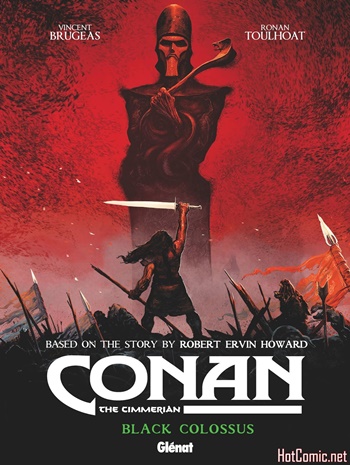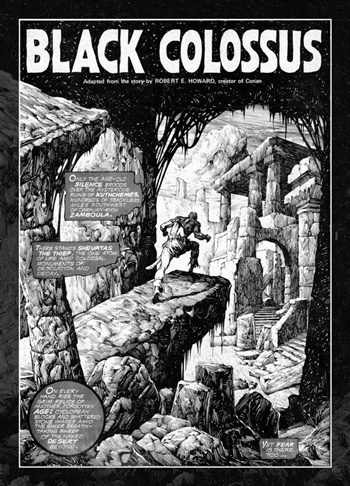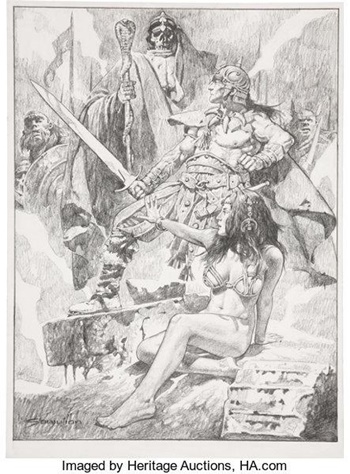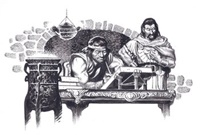Hither Came Conan: Deuce Richardson on “Black Colossus”
 It’s our second-to-last story essay here at Hither Came Conan. Deuce Richardson, who I’ve talked a lot of REH with, looks at “Black Colossus.” And he digs deep on this one. You absolutely should read on!
It’s our second-to-last story essay here at Hither Came Conan. Deuce Richardson, who I’ve talked a lot of REH with, looks at “Black Colossus.” And he digs deep on this one. You absolutely should read on!
Robert E. Howard’s “Black Colossus” is the greatest Conan yarn ever written. Within it, Howard distilled–for the first and best time–nearly all the elements that Conan fans have loved over the course of the last nine decades. Saddle up, REH fans. This is going to be one wild and bloody ride.
The tale begins in the deserts of eastern Shem, a hundred miles northeast of Stygia. There we find Kuthchemes, the ruined and shunned city once ruled by the wizard-king, Thugra Khotan, in the days when the Stygian dominion marched all the way to the rugged uplands of eastern Koth.
Shevatas, master-thief of Zamora–itself the City of Thieves in a nation of thieves–has spent long years preparing to plunder the tomb of Thugra Khotan. Robert E. Howard describes him thus:
“This was Shevatas, a thief among thieves, whose name was spoken with awe in the dives of the Maul and the dim shadowy recesses beneath the temples of Bel, and who lived in songs and myths for a thousand years.”
Shevatas penetrates the ivory-domed sepulchre, achieving his life-long dream…and then dies “as no man has died in three thousand years.”
Here lies the first bit of genius within “Black Colossus.” Namely, REH gives his readers the last chapter of a fine sword-and-sorcery tale as the first chapter of his Conan yarn. The tale of Shevatas is a mini-epic in itself and it makes a perfect blood n’ thunder intro to the main story.
Not only does it serve up great action–mortal combat against that archetypical Howardian antagonist, a giant serpent–but it also introduces eldritch, Lovecraftian horror from the git-go, which is a well-nigh essential ingredient in great sword-and-sorcery tales.
In Chapter II, the scene shifts several hundred miles northwest to the frontiers of Koth, where the small kingdom of Khoraja awaits the sudden onslaught of the mysterious Natohk–the Veiled One–and his desert hordes. The king of Khoraja has been abducted and his sister, Princess Yasmela, rules in his stead. She is renowned for her beauty across the Hyborian lands. The princess’ forces consist of little more than some aristocratic heavy cavalry, some Shemitish horse-archers and a mercenary regiment commanded by Amalric the Nemedian. Yasmela suffers nightly visits from Natohk, who projects his soul into her very bed-chamber. Tormented and at wit’s-end, Yasmela has lost faith in the priests of Ishtar, who had promised her protection from Natohk’s sendings.
Yasmela’s hand-maiden, Vateesa, persuades her to consult the forgotten oracle of Mitra in the depths of the palace. Both women are filled with trepidation and awe when they enter the chapel. Mitra’s voice speaks to them:
“In one manner may you save your kingdom, and saving it, save all the world from the fangs of the serpent which has crawled up out of the darkness of the ages. Go forth upon the streets alone, and place your kingdom in the hands of the first man you meet there.”
Yasmela follows Mitra’s command and the first man she meets is Conan the Cimmerian, a captain of Amalric’s mercenaries. Her decision is greeted with consternation from both her own nobles and from Conan’s commander, Amalric. The princess resolutely stands her ground and Conan is grudgingly accepted as the general of Khoraja’s forces.
This section of the tale demonstrates another facet of Howard’s genius. When Conan first discovers Yasmela’s true identity, he freely offers to cut someone’s throat for her, with no prompting. Shortly after, Amalric calls the Cimmerian “Conan the Throat-Slitter,” as if it were the man’s nickname among the mercenaries. Now, “throat-slitter” isn’t generally considered the most complimentary of sobriquets. However, it does bestow a bit of dark glamour, of ruthlessness, upon the Cimmerian. This is a guy who doesn’t always play by the rules. REH used this technique with several of his protagonists. The reader never sees the hero of the yarn actually cross the line, but he still feels the frisson of knowing that the guy he’s rooting for can get truly down n’ dirty if need be. This subtle technique is just one of many in Bob Howard’s toolkit.
Chapter III sees the army of Khoraja, under the command of Conan, on the march to the border pass where they will face Natohk. Courageously, Yasmela chooses to leave her palace and ride with her army, come what may. Tales of the veiled prophet’s power have reached a demonic crescendo. He appears unstoppable, especially since his Zuagir hordes and thaumaturgic might have been augmented by the addition of the mundane–but quite formidable–forces led by the most deadly Prince Kutamun of Stygia.
The night before the battle, Conan is visited by an old friend, a thief of Shumir whom the Cimmerian had known during his Zamorian thieving days. By dim firelight, in a masterfully-wrought scene, the Shumiri reveals to Conan that, in Natohk, he actually faces the resurrected Lord of Kuthchemes, Thugra Khotan. The words of the Shumiri are sheer poetry:
“Whence came Natohk?” rose the Shemite’s vibrant whisper. “Out of the desert on a night when the world was blind and wild with mad clouds driven in frenzied flight across the shuddering stars, and the howling of the wind was mingled with the shrieking of the spirits of the wastes. Vampires were abroad that night, witches rode naked on the wind, and werewolves howled across the wilderness. On a black camel he came, riding like the wind, and an unholy fire played about him, the cloven tracks of the camel glowed in the darkness.”
Conan believes the tale he’s told, but it does not shake his resolve. Beside whatever glory or plunder might eventuate if he does defeat Natohk and his hordes, Conan has the fate of thousands of brave men, of Yasmela and–quite possibly–of all the Hyborian lands resting on his shoulders. When chided by Amalric for not acting like the headlong Throat-Slitter of old, Conan retorts he behaved like that in the past,“[W]hen I had only my own life to consider.”
Natohk uses sorcery to, almost, surprise Conan’s forces. The knights of Khoraja, following the lead of Count Thespides, are lured into a charge and annihilated. The Cimmerian heads off a rout among his remaining troops through brute force and cold courage. The Khorajan forces stand to and prepare to meet their doom, swords in hand.
The battle that ensues is, in my opinion, the best scene of mass combat in any Conan story and possibly the best that Howard ever wrote. The stakes are about as high as they can be, with the Khorajan forces facing victory or death with their backs to the wall. Brutal, grinding shield-to-shield infantry combat alternates with hell-for-leather cavalry maneuvers and last-minute flank attacks. Conan himself, abandoning hope, leads a death-ride charge into the midst of Natohk’s throng:
“Down the steep slope they rushed, and a score lost their footing and rolled under the hoofs of their comrades. Below them men screamed and threw up their arms—and the thundering charge ripped through them as an avalanche cuts through a forest of saplings. On through the close-packed throngs the Khorajis hurtled, leaving a crushed-down carpet of dead.”
 Against all odds, the desert horde breaks and Conan meets the giant Prince Kutamun in a truly savage hand-to-hand showdown, with the Stygian seeking only to slay his foe on a battlefield of broken dreams.
Against all odds, the desert horde breaks and Conan meets the giant Prince Kutamun in a truly savage hand-to-hand showdown, with the Stygian seeking only to slay his foe on a battlefield of broken dreams.
In the midst of all this, Natohk, his own dreams of empire and vengeance shattered, abducts Yasmela. He no longer plans to make her his concubine, but instead seeks to replenish his necromantic energies by devouring her soul. His demon familiar, sensing Natohk’s weakness, abruptly abandons his master, allowing Conan to corner the Stygian wizard-king in the ruins of a desert temple. The Cimmerian disrupts Natohk’s ritual, leaving the weakened necromancer easy prey for cold steel.
Conan–like any good commander–then seeks to return and learn the fate of his surviving troops. Yasmela is having none of it. After bearing up under unimaginable strain for weeks, she demands that Conan satisfy her passions in this one, shared, stolen moment alone before she has to return to her world of courtiers and bureaucrats. Conan doesn’t have to be told twice.
This is the classic Conan story. Ancient evil, a passionate woman hungry for a barbarian’s embrace and blood-letting for high stakes on a massive scale. REH’s earlier novella, “The Scarlet Citadel,” attempted to do what “Black Colossus” does, but failed in some ways. The Hour of the Dragon was another, later try at the same thing, but the romantic element was more subdued and the battle scenes don’t quite measure up to BC. Also, sword-and-sorcery tales tend to function better at novella length than at novel length, in my opinion.
Beyond its status as a template, the story has unexpected depths in numerous areas. For one thing, I’ve come around to having some sympathy for Count Thespides. Here was a man who thought he had the inside track on marrying one of the hottest women in the Hyborian lands with various royal perks thrown in. Along comes some bone-gnawing outlander–not even a Hyborian–from left field. The outlander proceeds to take the top military post in Khoraja and catch the eye of Yasmela.
Thespides does not defect to the Kothians or Natohk. Nor does he lead a military coup and put Yasmela in “protective custody.” Thespides had plenty of options. Instead, he hangs in there. He stays true to his princess, his country and his honor. He doesn’t snap until faced with almost certain doom, at which point he dies charging the enemy. A brave man. Perhaps not the most pleasant guy. Undoubtedly arrogant, but you don’t reach adulthood within the warrior-caste of a small kingdom which is surrounded by enemies while being incompetent and gutless. Thespides simply reached his breaking point.
Yasmela is another example of Howard crafting a complex character. I’ve seen her referred to as a pampered princess and written off as a defenseless airhead. That is not what REH shows us in this tale. We first learn of Yasmela in her role as default ruler of Khoraja. Her brother, the king of Khoraja, is imprisoned in neighboring Ophir. His release is not imminent. Does she hand off her power to Taurus, her chancellor, or Thespides? Absolutely not. It is her obligation to rule and she does not shirk that responsibility. All this, despite storm-clouds of war on the horizon and terrifying nocturnal visits from the “soul” of Natohk.
 Speaking of those visits… I’ve seen online commenters disparage Yasmela’s terror in the face of Natohk’s psychic onslaught. Give me a break. For those who think they could calmly listen to the disembodied voice of a wizard-king dead for three millennia promising to inflict “the ancient forgotten ways of pleasure” upon them whether they like it or not: I say, go ahead and cast the first stone.
Speaking of those visits… I’ve seen online commenters disparage Yasmela’s terror in the face of Natohk’s psychic onslaught. Give me a break. For those who think they could calmly listen to the disembodied voice of a wizard-king dead for three millennia promising to inflict “the ancient forgotten ways of pleasure” upon them whether they like it or not: I say, go ahead and cast the first stone.
Yasmela held up quite well under Thugra Khotan’s nightly torments, all things considered. When presented with a solution–consulting the oracle of Mitra–she seized it with both hands. Upon receiving the answer to her question, Yasmela didn’t start second-guessing things. She made a decision–the right one–and stuck to it. Yasmela even overrode the cautionings of Vateesa–a life-long worshipper of Mitra–and went out on the benighted streets alone to fulfill Mitra’s command and find her destiny, come what may. So much for the “pampered princess.”
Finding Conan, Yasmela brings him back and interrogates him to see if he truly is qualified to lead the Khorajan forces into battle. She then backs down her entire cabinet and foists the unknown Cimmerian adventurer upon them as supreme commander. What a delicate flower!
The next day, Yasmela rides with her forces to what is probably certain doom. Natohk/Thugra Khotan has rolled over every opponent like a juggernaut and now he has a Stygian prince to make things really interesting. Without a doubt, Yasmela could’ve fled with the Khorajan crown jewels and found herself a noble husband in Brythunia or Nemedia. She did not. She steadfastly believed in Mitra and did her forebears proud, facing the greatest threat Khoraja had ever known.
Once again, I’ve seen certain poindexters whine about Yasmela not grabbing a sword like the Cimmerian women Amalric mentions. Could those Cimmerian viragos read and write? Could they deal constructively with courtiers and bureaucrats? Yasmela was raised with a certain skill-set. She took that and made up the difference with good instincts and a whole lot of raw courage.
As the battle royale is joined, Yasmela does not cower passively and let the men just do what they do. When Conan does not support the headlong charge of Thespides, she wants to know why. At the same time, Yasmela does not try to micromanage the battle, letting Conan make the decisions that ultimately win the day.
When Natohk lies dead with a yard of Hyborian steel through his heart, Yasmela demands what she wants from Conan, affairs of state and consequences be damned.
No, Robert E. Howard did not write a weak female character in Princess Yasmela of Khoraja.
It’s a shame that Howard never crafted the full tale of Shevatas. Somebody needs to. I’ve heard grisly whispers under midnight trees that a Southron scribe whose name begins with “Scott” and ends with “Oden” just may have such an epic in the works.
From the Dusty Scrolls (Editor comments)
Shevatas is one of the most intriguing supporting characters in the Conan Canon, even though he had a very brief appearance.
I wrote a post on the Khorajan elements in various pastiches.
“Black Colossus” was adapted by Roy Thomas for Savage Sword of Conan #2. Of course, it was in black and white. It was reprinted in full color in Marvel Treasury Edition #15 in 1977. Dark Horse adapted it for Conan the Cimmerian #8 – 13, in 2010.
Prior posts in the series:
Here Comes Conan!
The Best Conan Story Written by REH Was…?
Bobby Derie on “The Phoenix in the Sword”
Fletcher Vredenburgh on “The Frost Giant’s Daughter”
Ruminations on “The Phoenix on the Sword”
Jason M Waltz on “The Tower of the Elephant”
John C. Hocking on “The Scarlet Citadel”
Morgan Holmes on “Iron Shadows in the Moon”
David C. Smith on “The Pool of the Black One”
Dave Hardy on “The Vale of Lost Women”
Bob Byrne on Dark Horse’s “Iron Shadows in the Moon”
Jason Durall on “Xuthal of the Dusk”
Scott Oden on “The Devil in Iron”
James McGlothlin on “The Servants of Bit-Yakin”
Keith West on “Beyond the Black River”
Fred Adams on “The Black Stranger”
Stephen H. Silver on “Man Eaters of Zamboula”
Keith J. Taylor on “Red Nails”
Ryan Harvey on “Hour of the Dragon”
The Animated Red Nails Movie that Never Happened
Mark Finn on “The God in the Bowl”
Bob Byrne on “Rogues in the House”
Bob Byrne on the the Khoraja Saga
Wolfe Deitrich on “Wolves Beyond the Border”
Jeffrey Shanks on “A Witch Shall Be Born”
Next week, our final story, as Patrice Louinet looks at “Queen of the Black Coast.”
Deuce Richardson was managing editor of The World Fantasy Award-nominated blog, The Cimmerian and is a Robert E. Howard Foundation Award winner. He blogs about Robert E. Howard, pulp and other topics (including Solar Pons creator August Derleth!) at multiple sites on the web. I’ve learned a lot from him.
 Bob Byrne’s ‘A (Black) Gat in the Hand’ was a regular Monday morning hardboiled pulp column from May through December, 2018.
Bob Byrne’s ‘A (Black) Gat in the Hand’ was a regular Monday morning hardboiled pulp column from May through December, 2018.
His ‘The Public Life of Sherlock Holmes’ column ran every Monday morning at Black Gate from March, 2014 through March, 2017 (still making an occasional return appearance!).
He organized ‘Hither Came Conan,’ as well as Black Gate’s award-nominated ‘Discovering Robert E. Howard’ series.
He is a member of the Praed Street Irregulars, founded www.SolarPons.com (the only website dedicated to the ‘Sherlock Holmes of Praed Street’) and blogs about Holmes and other mystery matters at Almost Holmes.
He has contributed stories to The MX Book of New Sherlock Holmes Stories – Parts III, IV, V and VI.
And he is in a new anthology of new Solar Pons stories, out now.

Now that’s a good argument! But one must, of course, quibble. Here’s my quibble: Zamora is not a city. Um, that’s pretty much it. Excellent exposition of the strengths of the story. If it has weaknesses, you won’t hear them from Richardson. A most able advocate! Bravo!
I can more than hold my own in writing about Sherlock Holmes and Solar Pons. Yeah, humble of me, eh?
But there are some folks writing absolutely great stuff about Robert E. Howard. Much better than what I can come up with, and Deuce is absolutely one of them.
He posts good stuff at the Swords of REH Forum, as well. I’m pretty sure he’s a moderator (or maybe it was co-founder) there
An informative and enjoyable post. You’ve definitely made me reconsider this story, one I’ve underestimated.
“I’ve heard grisly whispers under midnight trees that a Southron scribe whose name begins with “Scott” and ends with “Oden” just may have such an epic in the works.”
And, if such a tale WERE in the works, perhaps it would be whispered in the nighted streets of Zamora that the first day of the month of Julius saw the first words of Shevatas’s epic life committed to papyrus . . .
I’m sorry I couldn’t come up with anything for the summer Gat posts, Bob. But don’t give up on me. Maybe later.
R.K. – Still time if you have a topic you want to hit. If not, maybe next time.
I got a little sidetracked the past couple weeks with Gabriel Hunt and Clive Cussler stuff. I’m in a bit of an adventure mode.
Brian: “Zamora is not a city.”
Zamora, like those other cities of thievery, New York and Mexico, was so nice they named it twice. “City of Thieves” is no more Zamora’s real name than “City of Lights” is the true name of Paris. REH referred to the city of Zamora at least once. “Arenjun” does not exist in a Howardian universe and carries no more weight than a fitful breeze. In a similar vein, the capital of Valusia is not rightly called the “City of Wonders”. Its actual name is “Valusia.”
Glad you liked the post!
Bob: Thanks for the kind words. I am a mod at the Swords forum. I also post regularly at the DMR blog, amongst other venues.
Mike: Glad I could give you a new perspective on BC!
Scott: Good news, O Southron Scribe!
All:
These are great posts… I think those new French comic adaptations of REH’s Conan warrant their own blog post here; from the little I’ve seen they seem pretty great.
Bob Byrne & RK,
It appears you’re discussing another topic, but I’d totally be down for a post about Clive Cussler/Gabriel Hunt. I’m currently really enjoying Ethan Gage in “Napoleon’s Pyramids”.
My personal opinion is that if you take Sword & Sorcery, set in modern world with no magic, you have Clive Cussler. Those characters and stories are (mostly) cut from the same cloth. (just noting that justify its inclusion here… Dirk Pitt would be at home on Black Gate just as much as Solar Pons is!)
A great effort, exactly what I expected from this series. My quibble would be there is not a shout out to Conan’s description of generalship.
Hessian – Yes. When this series wraps up (next week, I hope), a pulp/hardboiled series will move into this Monday morning slot.
It ran from May to December of last year. I wanted to revive it and cover more neat stuff.
I’m going to try and write a post on the Gabreil Hunt series. I just read the first two books, which I liked. I’m kinda stuck on three, as I’m not a Christa Faust fan. I may quit that and move on to the next one.
I am way behind on four of Cussler’s series, and only just read the first Fargo book last week. But I was a HUGE fan of Dirk Pitt until Cussler introduced Pitt’s two kids. I thought the series was much less interesting. And then he handed the series over to his son and I found I didn’t like the books any more. I quit reading Pitt at that point.
But I like the Kurt Austin books and am currently reading the Navigator while listening to Medusa on audio. Austin replaced Pitt pretty easily fo1r me.
I liked the first three Isaac Bell books and will get back to that one some day.
And I find the Oregon Files books a bit tech heavy for me, but I still like them and read the first four or five. I’ll continue on with those at well.
So, I’m going to try and write some form of a Cussler post in the upcoming series, as a continuation of the adventure pulps and Doc Savage (rather than mess around with Doc, I got the best name in the field to write about that topic!).
Terry:
Glad you liked it! I considered putting that in and also more of a look at the scene following right after, but I knew this was going to be a long one and decided to gloss over it. To be honest, I could’ve written twice as much. To me, Howard’s yarns–at least the better 50%–are almost “biblical” in regard to hidden depths and the way they lend themselves to analysis.
Great post!
There are other Conan tales that I like as much as Black Colossus but none that I like better and Mr. Richardson does a fine job of describing why.
Two things:
1. I initially thought that the first picture was a movie poster and was wracking my brains as to why I had never heard of such a film. Black Colossus would make a great movie!
2. A tale of Shevatas the Great??? By Scott Oden! Sign me up!
Fantastic job Deuce. I heartily agree with your sentiments. Man when you got to the battle it was like I was there, ah great memories of one of the strongest Conan stories.
John:
Yeah, that cover from the Glenat comic adaptation is pretty epic, which is why I chose it. I’ve been saying for 10+yrs that BC is the natural choice to start a Conan film franchise.
Tony:
Glad you liked the post! Yeah, I really wanted to convey to those who hadn’t read the story just how epic and savage the battle is in BC.
Fun read, Deuce; I appreciate your passion. Also like how you point-by-point showed Yasmela’s fortitude and Howard’s strategic writing of her.
I’d invite you to write for RBE’s Gathering now and again, but it seems your writing obligations abound. Keep on sharing your thoughts, Deuce – I am among the countless who find them of value.
Jason:
Glad you enjoyed the post!
When it comes to REH, I’m never low on passion.
As far as writing for RBE…as Dickens once put it: “Never say never.”
[…] E. Howard (Black Gate): Robert E. Howard’s “Black Colossus” is the greatest Conan yarn ever written. Within it, […]
[…] E. Howard (Black Gate): Robert E. Howard’s “Black Colossus” is the greatest Conan yarn ever written. Within it, […]
Damn.
Maybe we should encourage Deuce to go in depth on EVERY Howard Conan story (or every Howard story PERIOD,) and show us how they ALL rule.
Tex
(put me down for a collected volume of same)
I’m late commenting on this, but you know what they say . . . Anyway, the last time I reread “Black Colussus”, when I got to the big battle scene at the end, I thought to myself, “Wait a minute. I’ve been there.” Didn’t take me long to figure out why I felt that way. Howard’s description of the landscape matches up perfectly with the way the Cap Rock looks in West Texas, out around Big Spring. I think this is another example (“Beyond the Black River” being another) of how Howard took his own surroundings and transformed them into the Hyborian Age. It’s a great battle scene, too, one of the best I’ve ever read.
Tex:
Thanks for the kind words!
Jim:
Good observation! We know that REH was kind of obsessed with the Caprock from both “Marchers of Valhalla” and from his letters. It IS an impressive formation. We actually have a mini-version of it here in my corner of SEK.
While REH very probably used the Caprock to visualize Khorajan geography, I have to think the entire battle itself was him doing a “What if the Battle of Hattin had gone the OTHER way?” I remember a guy on social media trying to say that Scott’s THE KINGDOM OF HEAVEN had “ripped off” REH’s “Black Colossus” (he was pig-ignorant about anything medieval except the Vikings). I had to inform him that REH was “ripping off” much of the political and military aspects of the Battle of Hattin.
[…] Adaptación del relato de Robert E. Howard «Black Colossus». Dibujos: John-Buscema […]